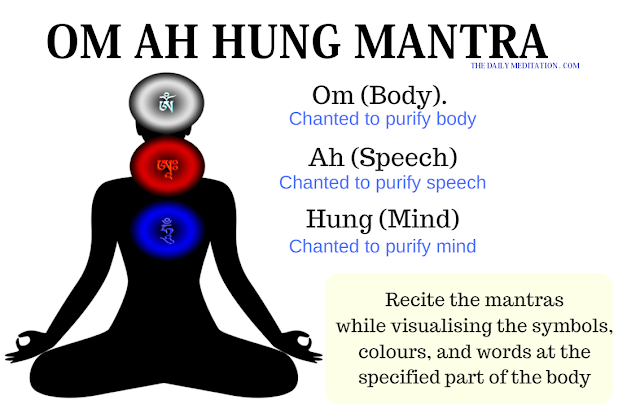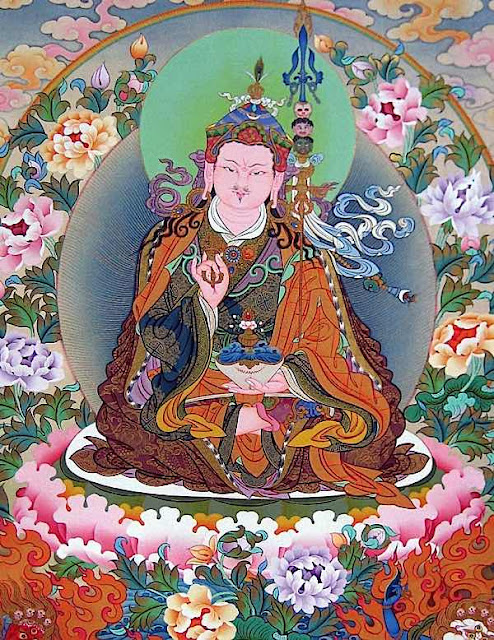A journey to a mysterious Himalaya snow land and it's unique Vajrayana Buddhism and the threatening culture.
Wednesday, September 29, 2021
Om Ah Hung - The Mantra of Inner Purification and Divination
Thursday, September 16, 2021
White Tara Long Life Prayer And Blessings
- Om - Representing the union of mind, body, and spirit that is at the heart of yoga.
- Tare – This syllable shows that Mother Tara liberates sentient beings from samsara.
- Tuttare – Liberates you from the eight fears related to the external dangers. However, the main dangers come from attachment, ignorance, anger, pride, miserliness, jealousy, doubt and wrong views.
- Ture – This syllable liberates you from the disease.
- Mama - Mine, means that I would like to possess the following qualities.
- Ayuh - Long life
- Punya - Merit that comes form living life ethically.
- Jnana - Wisdom
- Pustim - Abundance” or ”an increase in wealth.
- Kuru - Do so! do it now!
- Svaha - Hail, or may blessings be upon
Sunday, September 12, 2021
The Three Jewels
Sunday, August 29, 2021
蓮花生大師七句祈請文 Seven line Prayer to Guru Rinpoche Padmasambhava
歐堅耶傑呢向燦
巴瑪給薩東波拉
雅燦巧格歐哲尼
巴瑪炯內義色紮
括德喀卓芒布果
且傑吉色達哲傑
辛吉洛協夏色所
革日班瑪斯德吽
第一句為蓮師出生之地
第二句為蓮師降生之方式
第三句為蓮師之稀有功德
第四句為蓮師聖名之殊勝
第六句為隨修者對蓮師之信心
第七句為蓮師加持賜成就
第八句以咒語印持。
有關這蓮花生大師七句祈請文的視頻,這是我們的Youtube 網站: https://youtu.be/eIbqxAWcb6U
請訂閱、點贊、分享、評論和支持我們的佛教 YouTube 頻道,通過點擊“訂閱”按鈕和通知來達到 1,000 名訂閱者的最低門檻🔔 謝謝。
蓮師為諸佛菩薩大慈悲和智慧威德力的化現,因此只要虔誠念誦他的金剛七句祈請文,即會得諸佛菩薩蓮師等無上殊勝的加持攝受。
蓮師為所有三根本(上師、本尊、空行護法)的主要代表,三者完全融入尊者,因此只要修持蓮師法,三根本已同時俱足,只要虔誠念誦蓮師七句祈請文,三根本即如雲海般聚集現前,賜予修行者共與不共的加持及成就。
寧瑪巴大圓滿龍欽寧體獨掌持有者多智欽大法王祝賀第三世多傑羌佛在寧瑪巴尤其是大圓滿龍欽寧體,很多修行法門都以蓮師為主為基,尤其是所有的上師相應法,而蓮師上師相應法中最主要的是七句祈請文,故此祈請文為大密宗金剛乘一切教法的根本。又因其由法性界中自然唱出、由蓮師親傳與二十五位心子,並曾發願:"凡唱誦此七句祈請文者,不管身在何處,必會降臨賜予加持。"因此虔誠念誦的人,所得到的加持是不可思議的,能於夢境中親見如彩虹般的蓮師智慧身,聞到奇異的檀香味,聽到空行母唱頌的美妙音聲和像達瑪嚕的鼓樂聲等等.
只要精进不断的念诵此七句祈请文,即可得证大智慧,邪门魔外无法侵入,天龙八部等世间的大力鬼神、死神、邪魔鬼怪等不能为害并随侍如仆,周遭的人也乐于相助,能快速证悟与莲师无二无别的金刚持佛地。莲师的佛行事业功德和成就殊胜,与诸佛陀无二无别,虽非贤劫千佛第二佛,而为藏人赞称之为欧坚第二佛,因此真实语的佛陀也不会欺骗我们,诚心的祈请,必会遵守诺言为我们赐予加持的。
Saturday, August 28, 2021
The King Of Prayers-Seven Line Prayer To Guru Rinpoche
So it's extremely powerful. And you should practice it at all times continually. If you really focus on the Seven-Line Prayer, then it is certain that the blessings will come. The blessings of Guru Rinpoche will spring out and be born in your mind stream.
Friday, August 20, 2021
The Myth of The Tibetan Monks and Yogis Meditation
- Mindfulness meditation.
- Spiritual meditation.
- Focused meditation.
- Movement meditation.
- Mantra meditation.
- Transcendental Meditation.
- Progressive relaxation. •
- Loving-kindness meditation.
Sunday, August 8, 2021
Ushnishavijaya Dharani in Sanskrit/梵文佛頂尊勝陀羅尼經
The purpose of this sutra is said to be to help sentient beings in a troubled and tumultuous world. According to this sutra, beings will leave suffering and obtain happiness, increasing in their prosperity and longevity, remove karmic obstacles, eliminate disasters and calamities, remove enmity and hatred, fulfill all wishes, and quickly be led into the Buddha's way.
It is held by some that when the Dharani is heard, it can imbue the Alaya consciousness with pure seeds that will help to lead one to Buddhahood. This mantra is also linked to Green Tara.
According to the text, major applications of this Dharaṇi include:1) Destroy calamities and rescue those in difficulties
2) Eliminate offenses and create good deeds
3) Purify all karmic obstructions
4) Increase blessings and lengthen lifespan
5) Attain anuttara-samyak-saṃbodhi
6) Relieve beings in the ghost realm
7) Benefit birds, animals and all crawling creatures
8) Increase wisdom
9) Revert the fixed karma
10) Eliminate various illness
11) Ensure the safety of the households, and having children to inherit the family pride
12) Harmonise husbands and wives
13) Be able to reborn in Sukhavati or other pure lands
14) Heal sickness inflicted by pretas
15) Request for rain
16) Destroy hells
If someone hears this Dharani even just for a moment, he will not undergo karmic retribution from evil karma and severe hindrances accumulated from thousands of kalpas ago, that would otherwise cause him to revolve in the cycles of birth and death - in all kinds of life forms in the evil paths.Hell, hungry ghost, animal, realm of King Yama, Asuras, ferocious animals, crawling creatures and even ants and other life forms...he will be reborn in the Buddhalands, together with all the Buddhas and Ekajati-pratibadda Bodhisattvas, or in a distinguished Brahmin or Ksatriya family, or in some other wealthy and reputable families.
Ushnishavijaya Dharani in Sanskrit:
Namo bhagavate trailokya prativiśiṣṭaya buddhāya bhagavate.
Tadyathā, om, viśodhaya viśodhaya, samâsama
Samantāvabhāsa-spharaṇa gati gahana svabhāva viśuddhe,
Abhiṣiñcatu mām. sugata vara vacana amṛtâbhiṣekai.
Ahara āhara āyuḥ saṃ-dhāraṇi. śodhaya śodhaya gagana viśuddhe.
Uṣṇīṣa vijaya viśuddhe sahasra-raśmi sam-codite.
Sarva tathāgatâdhiṣṭhānādhiṣṭhita mahā-mudre.
Vajra kāya sam-hatana viśuddhe.
Sarvāvaraṇâpāyanagati pariviśuddhe, prati-nivartaya āyuḥ śuddhe.
Samayâdhiṣṭhite. maṇi maṇi mahāmaṇi.
Tathatā bhūta-koṭi pariśuddhe. visphuṭa buddhi śuddhe.
Jaya jaya, vijaya vijaya. smara smara, sarva buddhâdhiṣṭhita śuddhe,
Vajri vajra garbhe vajram bhavatu mama śarīram.
Sarva sattvānām ca kāya pariviśuddhe. sarva gati pariśuddhe.
Sarva tathāgata samāśvāsâdhiṣṭhite.
Budhya budhya, bodhaya bodhaya, śuddhe.


















































